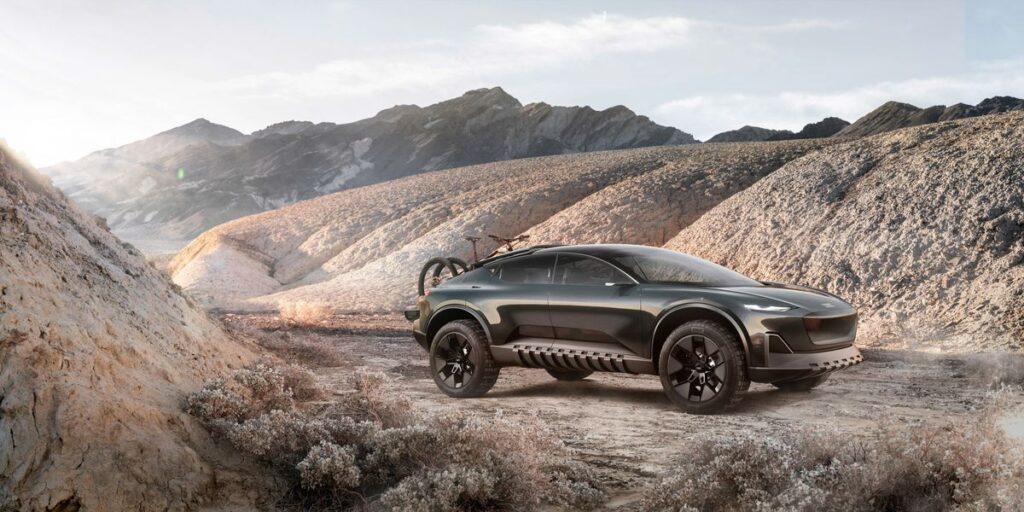Audi Activesphere Is an Off-Roader with No Screens, AR, and a Truck Bed

The Audi Activesphere is the latest in a series of “Sphere” concepts, and takes the shape of an off-road-oriented crossover with a coupe-like roofline. The highlight is the cabin, which uses augmented reality for all of the vehicle controls—like navigation, climate, and entertainment—instead of a screen.Another cool feature on the Activesphere is the split tailgate, which sees the rear glass slide upwards to turn the cargo area into an exposed bed for hauling bikes and other gear.
The Audi Activesphere concept blurs the lines between automotive segments, combining a sloping, carlike roofline with a decidedly SUV-esque stance and ride height. The fourth in Audi’s series of “Sphere” concepts—after the Skysphere roadster, Grandsphere sedan, and Urbansphere minivan—the Activesphere imagines a smoothly styled crossover that supports an outdoorsy lifestyle and shows off new technologies that Audi hopes to implement in the coming decades.
Like its conceptual companions, the Activesphere is electric, riding on the PPE platform that will underpin the upcoming A6 e-tron as well as Porsche’s electric Macan. A 100.0-kWh battery provides over 370 miles of range, and electric motors on the front and rear axles combine for 436 horsepower and 531 pound-feet of torque. PPE also brings 800-volt electrical architecture, allowing the battery to add around 186 miles of range in 10 minutes at 270 kW. Audi also claims the battery can go from 5 to 80 percent in under 25 minutes.
The Activesphere stretches nearly as long as a gas-powered Audi Q8, but it’s 3.0 inches wider, stands about 4.0 inches less tall, and has a 1.0-inch shorter wheelbase. The concept rides on an air suspension with adaptive dampers and 22-inch wheels wrapped in 285/55 tires designed to tackle a variety of terrains. The wheels feature active aero—opening up when off-roading for cooling and closing when on pavement to improve efficiency. Cameras replace traditional sideview mirrors to decrease drag, boosting range.
The focus on off-road exploration led to a see-through interpretation of the “Singleframe” grille that has adorned Audis over the past two decades, so the driver can better spot obstacles in front of the vehicle. The lower portions of the doors are also glass. The 8.2 inch ride height can be raised by 1.6 inches when leaving the asphalt, and Audi quotes the approach angle at a decent 18.9 degrees while the departure angle is a more versatile 28.1 degrees.
One of the Activesphere’s niftiest features is the “active back.” Essentially a split tailgate, the lower section folds down like on a pickup truck while the rear glass slides upwards, turning the cargo area into a small bed which can hold a pair of bicycles. A motorized bulkhead behind the rear seats keeps the cabin enclosed, and a ski rack is integrated into the roof. The Activesphere is the first Audi designed with a split tailgate, but the brand was coy about production feasibility.
Audi gets really experimental inside the Activesphere’s cabin. There is still a steering wheel and pedals, but the physical controls fold away when autonomous driving is activated. Straight lines dominate the simple dashboard, which includes a full-width sound bar and air vent. Red trim pops against the black background, and the center console has heated and cooled beverage storage.
You may have noticed that the Activesphere bucks the trend of giant touchscreens. That’s because the entire interior is the screen, thanks to the extensive use of augmented reality. Four headsets—stowed in a console in the roof—allow occupants to engage with what the automaker calls the “Audi dimensions.” The system basically layers information and controls over what you can see and physically interact with in the real world—similar to what Iron Man uses to work on his suits in the Marvel films, although you will need to don special glasses and probably aren’t as effortlessly charismatic as Robert Downey Jr.
Vehicle status, navigation, and entertainment are all included in the augmented reality interface, and the system tracks the user’s eyes, calling up more detailed information if the user focuses on a certain menu or display. Gesture control allows the user to interact with the virtual controls they are seeing like they would with a physical control, rotating to adjust a dial or tapping to click a button.
The augmented reality can also extend beyond the cabin—when off-roading, a topographical map can be projected onto the surrounding environment, while traffic information, routes, and safety warnings can also be layered onto the driver’s view of the road when commuting. The passengers, meanwhile, can see their own individual feed, adjusting their climate or entertainment settings or researching restaurants or activities for the final destination. Audi also says the headsets can be used outside of the car, either to monitor the vehicle’s condition or when engaging in sports like skiing or biking.
While the Activesphere’s exterior design doesn’t look too far-fetched, the sci-fi interior is certainly years—if not decades—away from production. Still, the unorthodox crossover provides a look into Audi’s crystal ball, hinting at what the electrified future of the brand might look like and the technologies Audi is developing that could change the way we use our cars’ interiors.
This content is imported from poll. You may be able to find the same content in another format, or you may be able to find more information, at their web site.




